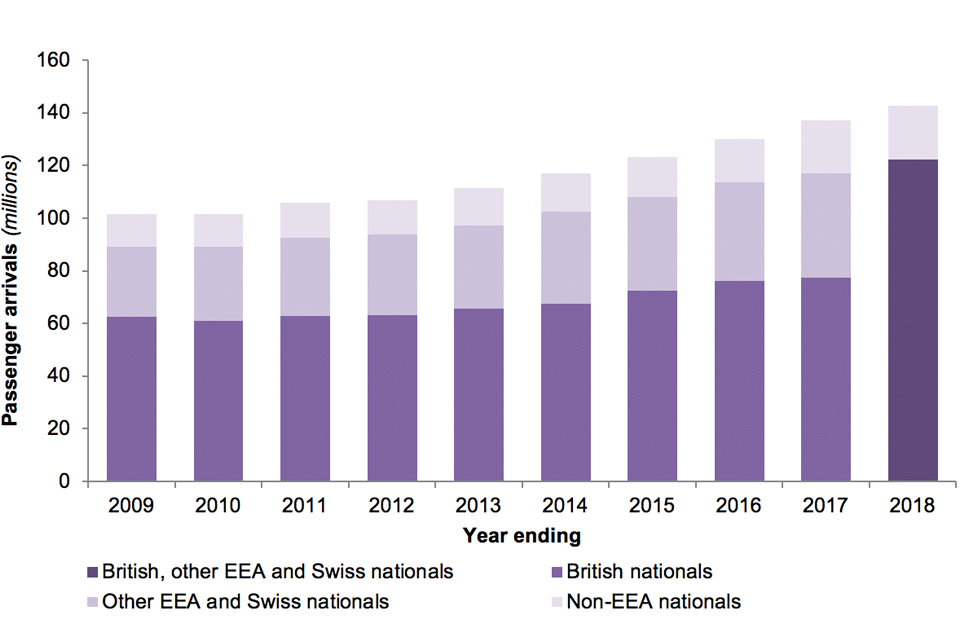How many people come to the UK each year?
Published 28 February 2019
Back to ‘Immigration Statistics, year ending December 2018’ content page.
This is not the latest release. View latest release.
Data in this section relate to the year ending December 2018 and all comparisons are with the year ending December 2017, unless indicated otherwise.
This section contains data on:
- the number of arrivals by people entering the UK
- grants of Entry clearance visas to individuals outside the UK
The Home Office provides a more detailed commentary on an annual basis. The latest detailed annual commentary is included in ‘Immigration statistics, year ending June 2018’.
1. Immigration to the UK
There were 142.8 million passenger arrivals in 2018 (including returning UK residents), a 4% increase of 5.7 million compared to the previous year and the highest number on record. The largest increases in the latest figures were:
- British, other EEA and Swiss nationals (up 5.2 million, or 4%, to 122.3 million); data from the year ending September 2018 (the latest available) suggests that around one-third were EEA and Swiss nationals
- Non-EEA nationals (up 0.5 million, or 3%, to 20.5 million); data from 2017 (the latest available by nationality) suggest that around 29% of these were US nationals
Most non-EEA nationals do not require a visa to visit or transit the UK, although they do still require a visa to come for other reasons. Therefore, the number of arrivals will be much higher than the number of visas granted.
There were over 2.9 million visas granted in 2018, a 7% increase of 197,524 compared with the previous year, continuing the upward trend seen over the last decade. Of these, over three-quarters (77%) were to visit, 8% were to study (excluding short-term study), 6% were to work, and 2% were for family reasons.
Figure 2: Passenger arrivals to the UK, by nationality group, 2009 to 2018

Source:
Table ad 01 q, Admissions tables.
Table note:
- Data separately identifying ‘British’, and ‘other EEA and Swiss’ nationals are published on an annual basis. The breakdown for the latest period will be available in the May 2019 release.
2. About these statistics
The statistics in this section provide an indication of the number of people who enter the UK.
The data do not show whether, or when, an individual arrived in the UK, what they did on arrival to the UK, or how long they stayed in the UK.
Many non-EEA nationals do not normally require a visa to visit the UK. As a result, they will be counted in the passenger arrivals data, but not in the visa data. A list of designated nationalities referred to as ‘visa nationals’ who do require a visa in order to visit the UK can be found in Immigration Rules Appendix V: visitor rules.
EEA and Swiss nationals do not require a visa to come to the UK for any reason.
Data on passenger arrivals are not directly comparable with data on Entry clearance visas granted for a number of reasons. A summary of what each dataset counts is provided below.
Passenger arrivals
Data on passenger arrivals relate to the number of arrivals into the UK. The data include British, EEA and Swiss nationals, as well as non-EEA nationals. For non-EEA nationals who are subject to immigration controls, more detailed information is available on their nationality and purpose of their journey.
Passenger arrivals are counted each time an individual enters the UK. Where an individual enters the UK more than once in a period, they will be counted each time they enter (but if they arrive each time on the same visa, they will be counted once in the visas data).
Entry clearance visas
Data on Entry clearance visas in this section refer to the number of visas granted for all reasons within the period. If an individual is granted a visa more than once in a given period, this will be counted as multiple grants in the statistics. If an individual enters the UK multiple times within the period for which a visa is valid, this will be counted as one grant in the visa statistics (but multiple arrivals in the passenger arrivals data).
Year-on-year comparisons of the number of decisions can be affected by quarterly fluctuations in the data. Such fluctuations can be examined in more detail in the quarterly data that are available in the published tables.
3. Data tables
Data on arrivals are available in:
Data on Entry clearance visas and sponsored visa applications for the Work, Study and Family routes (described further in the Work topic, Study topic and Family topic) can be found in:
We welcome your feedback
If you have any comments, or suggestions for the development of this report, please provide feedback by emailing MigrationStatsEnquiries@homeoffice.gov.uk. Please include the words ‘PUBLICATION FEEDBACK’ in the subject of your email.
See section 7 of the ‘About this release’ section for more details.
